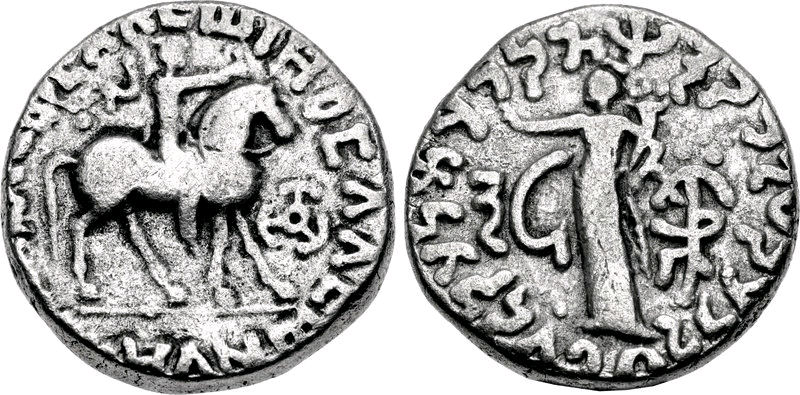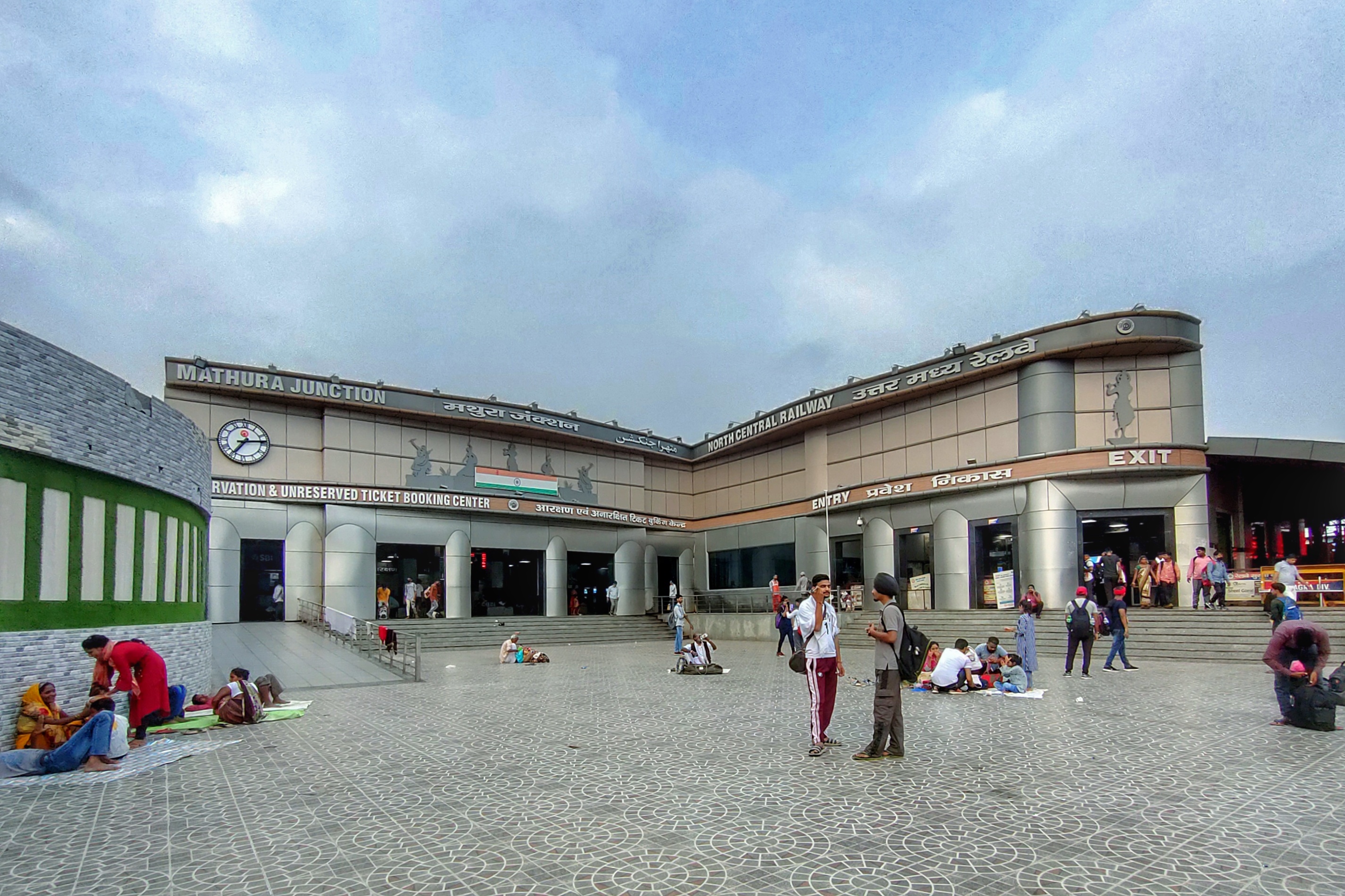|
Ayasia
The Mathura lion capital is an Indo-Scythian sandstone capital (a part of a pillar) from Mathura in Northern India, dated to the first decade of the 1st century CE (1–10 CE). It was consecrated under the rule of Rajuvula, one of the Northern Satraps of the region of Mathura. The capital was unearthed at the Saptarishi mound of Mathura by Bhagwan Lal Indraji in 1869. It is covered with Prakrit inscriptions in the kharoshthi script of northwestern India. The capital was made on the occasion of the funeral of "the illustrious king Muki and his horse" (Muki has been conjectured to be Maues). The capital describes, among other donations, the gift of a stupa with a relic of the Buddha, by Queen Ayasia, the "chief queen of the Indo-Scythian ruler of Mathura, satrap Rajuvula". The Mathura lion capital, an Indo-Scythian sandstone capital from Mathura in Central India, and dated to the 1st century CE, describes in kharoshthi the gift of a stupa with a relic of the Buddha, by queen Nada ... [...More Info...] [...Related Items...] OR: [Wikipedia] [Google] [Baidu] |
Rajuvula
Rajuvula (Greek ; Brahmi: , ; Kharosthi: , ; , ; , ) was an Indo-Scythian Great Satrap (''Mahākṣatrapa''), one of the " Northern Satraps" who ruled in the area of Mathura in the northern Indian Subcontinent in the years around 10 CE. The Mathura lion capital was consecrated under the reign of Rajuvula. In central India, the Indo-Scythians had conquered the area of Mathura from Indian kings around 60 BCE. Some of their satraps were Hagamasha and Hagana, who were in turn followed by Rajuvula. Name Rajuvula's name is attested on his coins in the Brahmi form and the Kharosthi forms (), (), and (), which are derived from the Saka name , meaning "ruling king" Biography Rajuvula is thought to have invaded the last of the Indo-Greek territories in the eastern Punjab, and replaced the last of the Indo-Greek kings, Strato II and Strato III. The main coinage of Rajuvula imitated that of the Indo-Greek rulers he supplanted. The Mathura lion capital, an Indo-Scythian sandsto ... [...More Info...] [...Related Items...] OR: [Wikipedia] [Google] [Baidu] |
Kharahostes
Kharahostes or Kharaosta ( Greek: , (epigraphic); Kharosthi: , , , ;) was an Indo-Scythian ruler (probably a satrap) in the northern Indian subcontinent around 10 BCE – 10 CE. He is known from his coins, often in the name of Azes II, and possibly from an inscription on the Mathura lion capital, although another satrap Kharaostes has been discovered in Mathura. He was probably a successor of Azes II. Epigraphical evidence from inscribed reliquaries show for certain that he was already "''Yabgu''-King", when the Indravarman Silver Reliquary was dedicated, which is itself positioned with certainty before the 5-6 CE Bajaur casket. There is some dispute however about the exact meaning of ''Yabgu''-King. For Richard Salomon, ''Yabgu'' means "tribal chief", in the manner of the Kushans, suggesting that Kharahostes was already fully king by the end of the 1st century BCE, supporting a 10 BCE- 10 CE date for his reign. For Joe Cribb, this is a misspelling by a careles ... [...More Info...] [...Related Items...] OR: [Wikipedia] [Google] [Baidu] |
Ayasia
The Mathura lion capital is an Indo-Scythian sandstone capital (a part of a pillar) from Mathura in Northern India, dated to the first decade of the 1st century CE (1–10 CE). It was consecrated under the rule of Rajuvula, one of the Northern Satraps of the region of Mathura. The capital was unearthed at the Saptarishi mound of Mathura by Bhagwan Lal Indraji in 1869. It is covered with Prakrit inscriptions in the kharoshthi script of northwestern India. The capital was made on the occasion of the funeral of "the illustrious king Muki and his horse" (Muki has been conjectured to be Maues). The capital describes, among other donations, the gift of a stupa with a relic of the Buddha, by Queen Ayasia, the "chief queen of the Indo-Scythian ruler of Mathura, satrap Rajuvula". The Mathura lion capital, an Indo-Scythian sandstone capital from Mathura in Central India, and dated to the 1st century CE, describes in kharoshthi the gift of a stupa with a relic of the Buddha, by queen Nada ... [...More Info...] [...Related Items...] OR: [Wikipedia] [Google] [Baidu] |
Northern Satraps
The Northern Satraps (Brahmi: , ''Kṣatrapa'', "Satraps" or , ''Mahakṣatrapa'', "Great Satraps"), or sometimes Satraps of Mathura, or Northern Sakas, are a dynasty of Indo-Scythian ("Saka") rulers who held sway over the area of Punjab and Mathura after the decline of the Indo-Greeks, from the end of the 1st century BCE to the 2nd century CE. They are called "Northern Satraps" in modern historiography to differentiate them from the " Western Satraps", who ruled in Sindh, Gujarat and Malwa at roughly the same time and until the 4th century CE. They are thought to have replaced the last of the Indo-Greek kings in the Punjab region, as well as the Mitra dynasty and the Datta dynasty of local Indian rulers in Mathura. The Northern Satraps were probably displaced by, or became vassals of, the Kushans from the time of Vima Kadphises, who is known to have ruled in Mathura in 90–100 CE, and they are known to have acted as Satraps and Great Satraps in the Mathura region for his su ... [...More Info...] [...Related Items...] OR: [Wikipedia] [Google] [Baidu] |
Indo-Scythian
The Indo-Scythians, also known as Indo-Sakas, were a group of nomadic people of Iranian peoples, Iranic Scythians, Scythian origin who migrated from Central Asia southward into the present-day regions of Afghanistan, Eastern Iran and the northwestern Indian subcontinent: present-day Pakistan and northern India. The migrations persisted from the middle of the second century BCE to the fourth century CE. The first Saka king in Greater India, India was Maues, Maues/Moga (first century BCE) who established Saka power in Gandhara, the Indus Valley, and other regions. The Indo-Scythians extended their supremacy over the north-western subcontinent, conquering the Indo-Greeks and other local peoples. They were apparently subjugated by the Kushan Empire's Kujula Kadphises or Kanishka. The Saka continued to govern as satrapies, forming the Northern Satraps and Western Satraps. The power of the Saka rulers began to decline during the 2nd century CE after the Indo-Scythians were defeated by ... [...More Info...] [...Related Items...] OR: [Wikipedia] [Google] [Baidu] |
Mathura Lion Capital Inscriptions
Mathura () is a city and the administrative headquarters of Mathura district in the Indian state of Uttar Pradesh. It is located south-east of Delhi; and about from the town of Vrindavan. In ancient times, Mathura was an economic hub, located at the junction of important caravan routes. The 2011 Census of India estimated the population of Mathura at 441,894. In Hinduism, the birthplace of Krishna, one of the main deities in that religion, is believed to be located in Mathura at the Krishna Janmasthan Temple Complex. It is one of the Sapta Puri, the seven cities considered holy by Hindus, also is called Mokshyadayni Tirth. The Kesava Deo Temple was built in ancient times on the site of Krishna's birthplace (an underground prison). Mathura was the capital of the kingdom of Surasena, ruled by Kamsa, the maternal uncle of Krishna. Mathura is part of the Krishna circuit (Mathura, Vrindavan, Barsana, Govardhan, Kurukshetra, Dwarka and Bhalka). Krishna Janmashtami is grandly cel ... [...More Info...] [...Related Items...] OR: [Wikipedia] [Google] [Baidu] |
Kharoshthi Inscription On Base Of Mathura Capital
Kharosthi script (), also known as the Gandhari script (), was an ancient script originally developed in the Gandhara Region of modern-day Pakistan, between the 5th and 3rd century BCE. used primarily by the people of Gandhara alongside various parts of South Asia and Central Asia. it remained in use until it died out in its homeland around the 5th century CE. It was also in use in Bactria, the Kushan Empire, Sogdia, and along the Silk Road. There is some evidence it may have survived until the 7th century in Khotan and Niya, both cities in East Turkestan. History The name Kharosthi may derive from the Hebrew ''kharosheth'', a Semitic word for writing, or from Old Iranian ''*xšaθra-pištra'', which means "royal writing". The script was earlier also known as ''Indo-Bactrian script'', ''Kabul script'' and ''Arian-Pali''. Scholars are not in agreement as to whether the Kharosthi script evolved gradually, or was the deliberate work of a single inventor. An analysis of the s ... [...More Info...] [...Related Items...] OR: [Wikipedia] [Google] [Baidu] |
Mathura Lion Capital Showing Triratana
Mathura () is a city and the administrative headquarters of Mathura district in the states and union territories of India, Indian state of Uttar Pradesh. It is located south-east of Delhi; and about from the town of Vrindavan. In ancient times, Mathura was an economic hub, located at the junction of important caravan (travellers), caravan routes. The 2011 Census of India estimated the population of Mathura at 441,894. In Hinduism, the birthplace of Krishna, one of the main deities in that religion, is believed to be located in Mathura at the Krishna Janmasthan Temple Complex. It is one of the Sapta Puri, the seven cities considered holy by Hindus, also is called Mokshyadayni Tirth. The Kesava Deo Temple was built in ancient times on the site of Krishna's birthplace (an underground prison). Mathura was the capital of the kingdom of Surasena, ruled by Kamsa, the maternal uncle of Krishna. Mathura is part of the Krishna circuit (Mathura, Vrindavan, Barsana, Govardhan, 48 kos pa ... [...More Info...] [...Related Items...] OR: [Wikipedia] [Google] [Baidu] |
Gautama Buddha
Siddhartha Gautama, most commonly referred to as the Buddha (),* * * was a śramaṇa, wandering ascetic and religious teacher who lived in South Asia during the 6th or 5th century BCE and founded Buddhism. According to Buddhist legends, he was born in Lumbini, in what is now Nepal, to royal parents of the Shakya clan, but Great Renunciation, renounced his Householder (Buddhism), home life to live as a wandering ascetic. After leading a life of mendicancy, asceticism, and meditation, he attained Nirvana (Buddhism), nirvana at Bodh Gaya, Bodh Gayā in what is now India. The Buddha then wandered through the lower Indo-Gangetic Plain, teaching and building a Sangha, monastic order. Buddhist tradition holds he died in Kushinagar and reached ''parinirvana'' ("final release from conditioned existence"). According to Buddhist tradition, the Buddha taught a Middle Way between sensual indulgence and severe asceticism, leading to Vimutti, freedom from Avidyā (Buddhism), ignora ... [...More Info...] [...Related Items...] OR: [Wikipedia] [Google] [Baidu] |
Sarvastivadin
The ''Sarvāstivāda'' (; ;) was one of the early Buddhist schools established around the reign of Ashoka (third century BCE).Westerhoff, The Golden Age of Indian Buddhist Philosophy in the First Millennium CE, 2018, p. 60. It was particularly known as an Abhidharma tradition, with a unique set of seven canonical Abhidharma texts.Westerhoff, 2018, p. 61. The Sarvāstivādins were one of the most influential Buddhist monastic groups, flourishing throughout North India, especially Kashmir and Central Asia, until the 7th century CE. The orthodox Kashmiri branch of the school composed the large and encyclopedic '' Abhidharma Mahāvibhāṣa Śāstra'' around the time of the reign of Kanishka (c. 127–150 CE). Because of this, orthodox Sarvāstivādins who upheld the doctrines in the ''Mahāvibhāṣa'' were called '' Vaibhāṣikas.'' There have been debates about the exact chronological emergence of Sarvastivadins from Sthavira nikāya. According to the Theravādin '' D ... [...More Info...] [...Related Items...] OR: [Wikipedia] [Google] [Baidu] |








